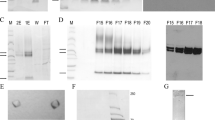Abstract
TRANSFORMING growth factor type β (TGF-β2)1 is a member of an expanding family of growth factors that regulate prolifer-ation and differentiation of many different cell types2,3. TGF-β2 binds to various receptors4, one of which was shown to be a serine/threonine kinase5. TGF-β2 is involved in wound healing6, bone formation7 and modulation of immune functions8. We report here the crystal structure of TGF-β2 at 2.2 Å resolution, which reveals a novel monomer fold and dimer association. The monomer consists of two antiparallel pairs of β-strands forming a flat curved surface and a separate, long α-helix. The disulphide-rich core has one disulphide bond pointing through a ring formed by the sequence motifs Cys-Ala-Gly-Ala-Cys and Cys-Lys-Cys, which are themselves connected through the cysteines. Two monomers are connected through a single disulphide bridge and associate such that the helix of one subunit interacts with the concave β-sheet surface of the other. Four exposed loop regions might determine receptor specificity. The structure provides a suitable model for the TGF-βs and other members of the super-family9–11 and is the basis for the analysis of the TGF-β2 interactions with the receptor.
This is a preview of subscription content, access via your institution
Access options
Subscribe to this journal
Receive 51 print issues and online access
$199.00 per year
only $3.90 per issue
Buy this article
- Purchase on Springer Link
- Instant access to full article PDF
Prices may be subject to local taxes which are calculated during checkout
Similar content being viewed by others
References
Cheifetz, S. et al. Cell 48, 409–415 (1987).
Roberts, A. B. & Sporn, M. B. Adv. Cancer Res. 51, 107–145 (1988).
Massagué, J. A. Rev. Cell Biol. 6, 597–641 (1990).
Cheifetz, S. & Massagué, J. J. biol. Chem. 266, 20767–20772 (1991).
Lin, H. Y., Wang, X.-F., Ng-Eaton, E., Weinberg, R. A. & Lodish, H. F. Cell 68, 775–785 (1992).
Cox, D. A., Kunz, S., Cerletti, N., McMaster, G. K. & Bürk, R. R. in Angiogenesis: Key Principles, Science, Technology, Medicine (eds Steiner, R., Weisz, B. & Langer, R.) 287–295 (Birkhäuser, Basel, Switzerland, 1992).
Joyce, M. E., Roberts, A. B., Sporn, M. B. & Bolander, M. E. J. Cell Biol. 110, 2195–2207 (1990).
Wrann, M. et al. EMBO J. 6, 1633–1636 (1987).
Mason, A. J. et al. Nature 318, 659–663 (1985).
Wozney, J. M. et al. Science 242, 1528–1534 (1988).
Wozney, J. M. Prog. Growth Factor Res. 1, 267–280 (1989).
Schlunegger, M. P. et al. FEBS Lett. 303, 91–93 (1992).
Tamaoki, H. et al. Prot. Engng. 4, 509–518 (1991).
Rees, D. C. & Lipscomb, W. N. Proc. natn. Acad. Sci. U.S.A. 77, 4633–4637 (1980).
Janin, J. & Wodak, S. J. molec. Biol. 125, 357–386 (1978).
Ogawa, Y. et al. J. biol. Chem. 267, 2325–2328 (1992).
Wang, X.-F. et al. Cell 67, 797–805 (1991).
Messerschmidt, A. & Pflugrath, J. W. J. appl. Crystallogr. 20, 306–315 (1987).
Wang, B.-C. Meth. Enzym. 115, 90–112 (1985).
Ikeda, T., Lioubin, M. N. & Marquardt, H. Biochemistry 26, 2406–2410 (1987).
Jones, T. A. J. appl. Crystallogr. 11, 268–272 (1987).
Brünger, A. T., Kuriyan, J. & Karplus, M. Science 235, 458–460 (1987).
Tronrud, D. E., Ten Eyck, L. F. & Matthews, B. W. Acta Crystallogr. A43, 489–451 (1987).
Priestle, J. P. J. appl. Crystallogr. 21, 572–576 (1988).
Lee, S.-J. Molec. Endocrin. 4, 1034–1040 (1990).
Wharton, K. A., Thomson, G. H. & Gelbart, W. M. Proc. natn. Acad. Sci. U.S.A. 88, 9214–9218 (1991).
Author information
Authors and Affiliations
Rights and permissions
About this article
Cite this article
Schlunegger, M., Grütter, M. An unusual feature revealed by the crystal structure at 2.2 Å resolution of human transforming growth fact or-β2. Nature 358, 430–434 (1992). https://doi.org/10.1038/358430a0
Received:
Accepted:
Issue Date:
DOI: https://doi.org/10.1038/358430a0
This article is cited by
-
Recombinant production, purification, crystallization, and structure analysis of human transforming growth factor β2 in a new conformation
Scientific Reports (2019)
-
Cloning, expression profiling and promoter functional analysis of Bone morphogenetic protein 6 and 7 in tongue sole (Cynoglossus semilaevis)
Fish Physiology and Biochemistry (2017)
-
New Strategy for High-Level Expression and Purification of Biologically Active Monomeric TGF-β1/C77S in Escherichia coli
Molecular Biotechnology (2015)
-
Reply to Regarding the mechanism of action of a proposed peptide agonist of the bone morphogenetic protein receptor activin-like kinase 3
Nature Medicine (2013)
-
Activin-like kinase 3 is important for kidney regeneration and reversal of fibrosis
Nature Medicine (2012)
Comments
By submitting a comment you agree to abide by our Terms and Community Guidelines. If you find something abusive or that does not comply with our terms or guidelines please flag it as inappropriate.



